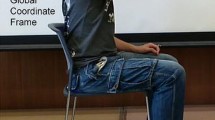Abstract
The movements studied involved moving the tip of a pointer attached to the hand from a given starting point to a given end point in a horizontal plane. Three joints — the shoulder, elbow and wrist —were free to move. Thus the system represented a redundant manipulator. The coordination of the movements of the three joints was recorded and analyzed. The study concerned how the joints are controlled during a movement. The results are used to evaluate several current hypotheses for motor control.
Basically, the incremental changes are calculated so as to move the tip of the manipulator along a straight line in the workspace. The values of the individual joints seem to be determined as follows. Starting from the initial values the incremental changes in the three joint angles represent a compromise between two criteria: 1) the amount of the angular change should be about the same in the three joints, and 2) the angular changes should minimize the total cost of the arm position as determined by cost functions defined for each joint as a function of angle.
By itself, this mechanism would produce strongly curved trajectories in joint space which could include additional acceleration and deceleration in a joint. These are reduced by the influence of a third criterion which fits with the mass-spring hypothesis. Thus the path is calculated as a compromise between a straight line in workspace and a straight line in joint space. The latter can produce curved paths in the workspace such as were actually found in the experiments.
A model calculation shows that these hypotheses can qualitatively describe the experimental findings.
Similar content being viewed by others
References
Abend W, Bizzi E, Morasso P (1982) Human arm trajectory formation. Brain 105:331–348
Atkeson CG, Hollerbach JM (1985) Kinematic features of unrestrained vertical arm movements. J Neurosci 5:2318–2330
Cruse H (1986) Constraints for joint angle control of the human arm. Biol Cybern 54:125–132
Fel'dman AG (1974) Change of muscle length as a consequence of a shift in an equilibrium of muscle load system. Biophysics 19:544–548
Hollerbach JM, Atkeson CG (1986) Characterization of joint-interpolated arm movements. In: Heuer H, Fromm G (eds) Generation and modulation of action patterns. Springer, Berlin Heidelberg New York, pp 41–54
Hollerbach JM, Flash T (1982) Dynamic interactions between limb segments during planar arm movement. Biol Cybern 44:67–77
Hollerbach JM, Moore SP, Atkeson CG (1986) Workspace effect in arm movement kinematics derived by joint interpolation. In: Gantchev G, Dimitrov B, Gatev P (eds) Motor control. Plenum Press, New York
Hollerbach JM, Suh KC (1985) Redundancy resolution of manipulators through torque optimization. In: Proceedings of the 1985 IEEE International Conference on Robotics and Automation, pp 1016–1021. Computer Soc. Press, Silver Spring
Kaminski T, Gentile AM (1986) Joint control strategies and hand trajectories in multijoint pointing movements. J Mot Behav 18:261–278
Morasso P (1981) Spatial control of arm movements. Exp Brain Res 42:223–227
Soechting JF, Lacquaniti F (1981) Invariant characteristics of a pointing movement in man. J Neurosci 1:710–720
Yoshikawa T (1984) Analysis and control of robot manipulators with redundancy. In: Brady M, Paul R (eds) Robotics research. The First International Symposium. MIT Press, Cambridge, Mass, London, pp 735–747
Author information
Authors and Affiliations
Rights and permissions
About this article
Cite this article
Cruse, H., Brüwer, M. The human arm as a redundant manipulator: The control of path and joint angles. Biol. Cybern. 57, 137–144 (1987). https://doi.org/10.1007/BF00318723
Received:
Issue Date:
DOI: https://doi.org/10.1007/BF00318723




